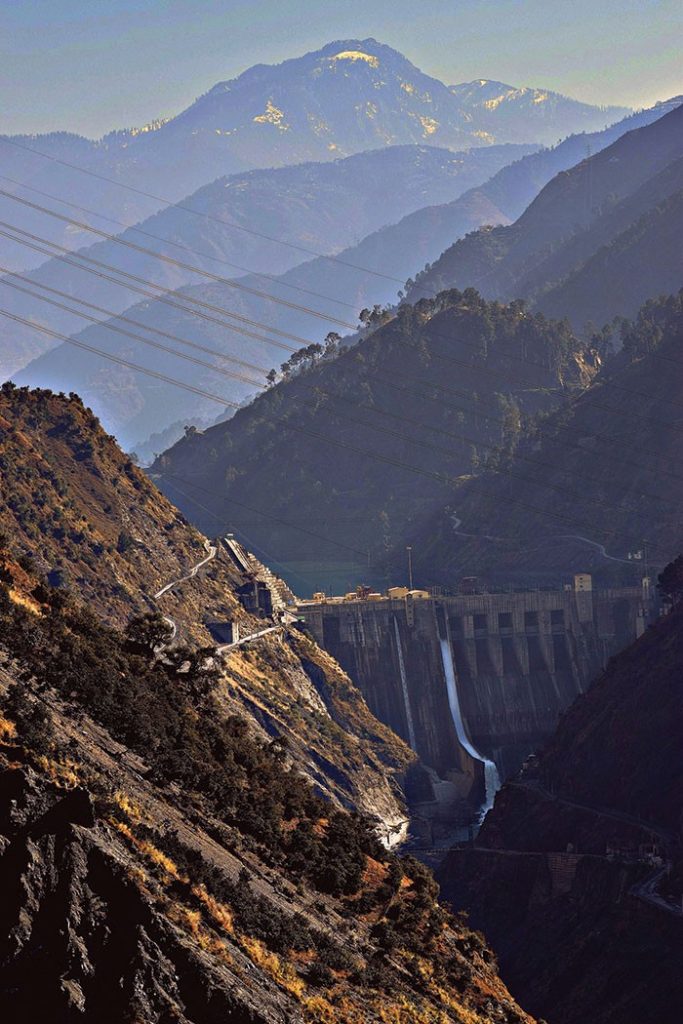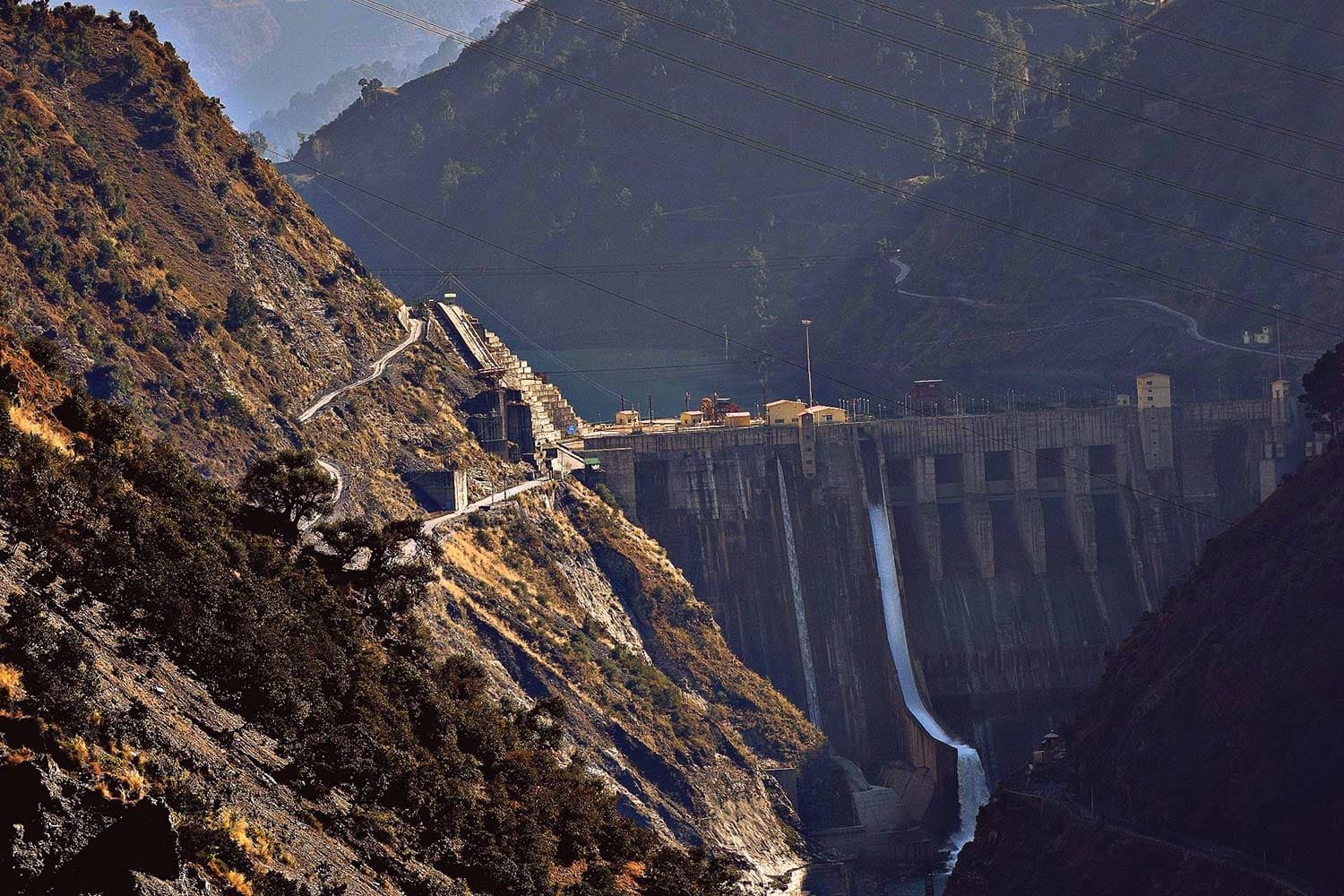Green Power at any Cost?
India’s plan to build seven new hydro dams in Kashmir will hurt ecosystems and Indigenous communities.
The Baglihar Dam in Kashmir was completed in 2008. The lack of adequate compensation for locals displaced by the dam’s reservoir is cause for concern for those who will be impacted by the Indian government’s new hydro-electric projects.
When I was 10, my nana (maternal grandfather) remained stuck in the dense forests of Kishtwar on the banks of Kashmir’s Chenab River for nearly a fortnight. I waited for him every day until late at night. Before going to bed, I would park myself beside my nani (maternal grandmother) and enquire about his return. My queries were met with the same assurance: “He will definitely come back tomorrow.”
That tomorrow came after 12 days. My nana came home with wild strawberries, mulberries, milk, and lots of maesh kreaj (local cheese) given to him by the Indigenous communities who lived in the forests.
I ran toward him, unable to contain my excitement and relief. My nana held me, tossed me up in the air, and kissed me on the forehead. I started bombarding him with questions, asking where and why he had disappeared for 12 days. “I was stuck in the forest due to work,” he said. My nana worked for the State of Jammu and Kashmir’s forest department, keeping a check on illegal hunting and tree-felling.
During the dams’ construction, hillsides will be blasted, trees will be cut down, and streams diverted.
When he returned from the forests, he brought something else with him: a story for each day. Through his stories, I learned how humans rely on water for survival, the nourishment forests hold for people and animals, and Indigenous peoples’ deep knowledge of the forest. One story I remember was about how Indigenous Gujjar women collect green dandelions (locally known as haand). Once clean and dried, they provide nutrients that boost the immunity of pregnant mothers.
In October 2020, on the banks of the same Chenab River my nana once described as fragile, the Indian government approved the construction of seven hydropower dams in the Kishtwar region. These dams will generate 5,190 megawatts of hydroelectricity as part of the Indian government’s push to shift from coal to renewable energy.
But in the lush forests and valleys of Kishtwar, the dams threaten delicate flora and fauna, and the ways of life of semi-nomadic and farming communities. Locals, activists, and scholars say the dams will come at huge environmental and human costs. Vast tracts of forest will be destroyed, and fertile agricultural land will be submerged, displacing over 20,000 people. Work on four of the seven dams is already underway.

Flooding from Baglihar Dam in Indian-controlled Kashmir submerged the village of Pul Doda in 2008.
“The power projects are coming up at the cost of the people, who forfeit their resources without getting anything from the government,” Zakir Bhat, a member of the Kishtwar district development council, told Outlook India. “We should be part of all decision-making about how to harness this region’s water resources.”
Since India’s independence in 1947, over 3,300 big dams have been built across the country, leading to the forced displacement of millions; advisasis (Indigenous people) have been particularly affected. The government offers compensation to those displaced, but it’s often meagre. Sometimes it doesn’t come at all. And, if it does, it probably won’t be enough to buy new land.
Gujjars and Bakerwals — semi-nomadic Indigenous pastoralists whose main occupation is rearing cattle — are among locals protesting the dams’ construction. These communities depend on the forests, and cultivate forest land to grow rice and lentils. At higher altitudes where fodder is unavailable, their cows eat wild forest grass. The government has promised them compensation, but community members say it won’t be enough to sustain them. They worry they will be pushed into poverty.
Local communities worry they will be pushed into poverty.
In the face of this news, I recalled the stories my nana had told me about the wealth of the forest. Forest-dwellers and officials posted inside the forest survived only thanks to the river, and forest produce. I recorded what he shared in my childhood diary. He told me he drank water from the Chenab and ate rice, lentils, chicken, and fish cooked by Gujjar women. Without their support, he would have struggled to sustain himself.
Today, I shudder when I think about what will happen to forest-dwellers once the dams are built. During construction, hillsides will be blasted, trees will be cut down, and streams diverted. Once the dams are complete, valley floors will be flooded. And the river ecosystems themselves will be changed. By trapping sediment, dams can bury rocky river beds where fish spawn. By slowing down or stopping the water, they can cause it to heat up, affecting temperature-sensitive species.
The cost of development
Pooran Chand, president of Kisthwar’s union of village labourers, has lived and worked in the green surroundings of Kishtwar all his fifty years. His family has farmed rice, millet, and lentils in the region for generations. They have witnessed devastation wrought by large-scale dams in nearby areas.
Chand recalls the construction of Baglihar Dam in the nearby Ramban district. Completed in 2008, the project displaced approximately 1,400 people. Flooding from the dam submerged the town of Pul Doda, destroying homes and businesses.
Any large dam poses ecological risks, and having seven in close proximity will only magnify those risks in Kishtwar.
Villagers in the district received little compensation in exchange for their fertile land and homes. They have lost their way of life, says Chand, noting that many are now day-labourers. Despite government promises of rehabilitation, many families rent small one- or two-room houses without water or electricity. Others are homeless.
“There is no stable option to manage their household expenses. They have to work twice as hard as before to get their families two square meals a day,” said Chand, who is staunchly opposed to the new dam projects in Kishtwar.
The façade of employment
Every summer, communities of Gujjars and Bakerwals used to migrate 600 km from the Kashmir Valley to land in the Himalayas with flocks of sheep, cows, buffaloes, and goats (land now flooded by the Baglihar Dam). Heavy blasting during dam construction destroyed their dhokas — temporary houses made of mud and woods — and rendered the territory unsafe. Now, they are forced to travel with their livestock to places they don’t know, sometimes running into conflicts with communities there.
The government has promised the new dams will generate jobs, but locals are skeptical. They lack basic skills required to work in construction. “Promoting these dams as avenues of job generation in the villages is merely a facade,” said Irshad, a Kishtwar resident from the Gujjar community. “It is of no help to people like us as we keep migrating from the Himalayas to the plains every six months. Instead, it impacts our dhokas.”
Tipping the ecological balance
The Chenab River flows into Kishtwar from Himachal Pradesh and flows out to four other districts in Jammu and Kashmir before reaching Pakistan. Any large dam poses ecological risks, and having seven in close proximity will only magnify those risks in Kishtwar.
The concerns reach beyond India to Pakistan. By altering the flow of the Chenab, the dams could reduce water available to Pakistani farmers. The project has ruffled political feathers in both countries, with Pakistan accusing India of violating a bi-lateral agreement about control over the rivers in the area.
Himanshu Thakkar, the coordinator of the South Asia Network on Dams, Rivers, and People–an informal network of organisations and individuals who work on issues related to large dams in South Asia — explained the dams are “run-of-river” projects, meaning they will generate energy from flowing water and have limited water storage.
Once the dams are running, water will flow irregularly through them, harming fish and other aquatic life, as well as fishermen who rely on the river for their livelihood, said Thakkar. “Since it is not possible to store electricity, these dams will operate during peak hours of demand,” he explained. “Water flow will be disrupted at sudden moments. At times, there will be no water available in the river and, at others, the flow will suddenly increase.”
When I was a child, my nana told me stories. In his last days, I read the news to him. The difference: he had good stories to tell, I had bad ones.
The Himalayas are already prone to disasters like landslides and flash floods. The dams could worsen the risk, according to Khurshid Ahmad Lone, a high school geology teacher in Handwara, Jammu and Kashmir. To make matters worse, an earthquake of magnitude 8.5 or higher is overdue in the Jammu region of the Himalayas, according to a 2018 study conducted by seismologists from the Bangalore-based Jawaharlal Nehru Centre for Advanced Scientific Research.
In addition, reservoirs release large amounts of methane — a greenhouse gas significantly more effective at trapping heat than carbon dioxide — as plants, plankton, algae, and soils at the bottom decompose.
When the news broke out about the approval of the Kishtwar dam projects, I was at my grandfather’s bedside. He had been diagnosed with cancer a few months earlier and I was taking care of his diet and medication. I read the news to him every day, and we discussed political developments that could lead to economic and environmental changes in the region.
That small ritual became a symbolic representation of the cycle of life for me. When I was a child, my nana told me stories about the ways of the world. In his last days, I read out the news and explained stories to him. However, there was a significant difference: he had good stories to tell, while I had bad ones.
When I read the report about dam construction, he turned to me and asked, “Where will the people go? Why is the government doing this? All my life I have protected these trees and now they will cut them down.”
Print Issue: Spring 2022
Print Title: Where Will the People Go?
